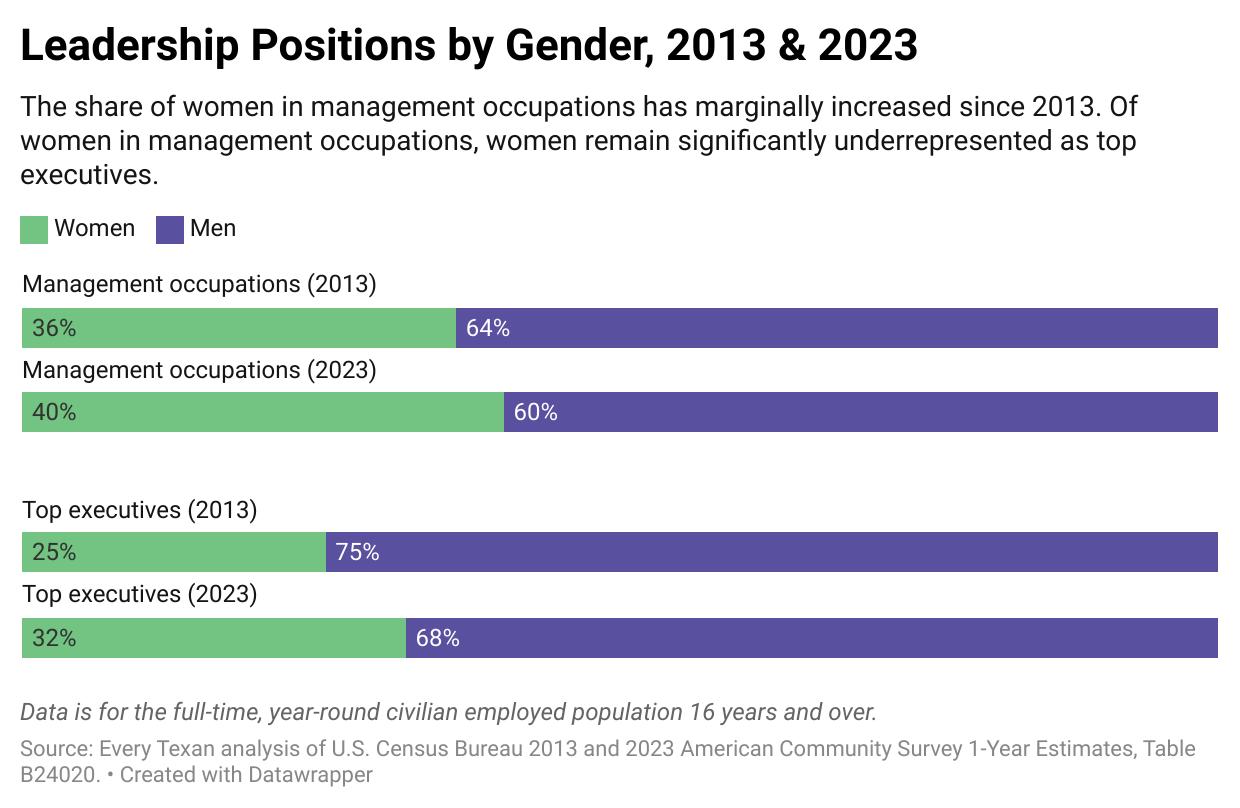

TEXAS WOMEN AND THE WAGE GAP TEXAS WOMEN AND THE WAGE GAP





This Corporate White Paper, based on the 2024 Economic Issues for Women in Texas report, offers crucial insights for businesses and organizations aiming to support women in the workforce. The document presents key data, strategies, and implementation tools to address the challenges faced by women, who make up 46% of the Texas workforce. By embracing these recommendations for workforce sustainability, companies can foster an environment where women and their families prosper, strengthening Texas's economy and enhancing its resilience.
Women Play a Pivotal Role in Driving the Texas Economy
Women are a driving force in Texas’s workforce and economy, making up 46% of the state’s workforce. Between 2013 and 2023, the number of women working fulltime, year-round grew by 33%, outpacing the 25% growth among men during the same period. Demographic projections show that the population of women in Texas will continue to grow and is expected to outpace men by over a million by 2060.

Given the significant role women will continue to play in the Texas workforce and the projected growth of the female population, addressing barriers to their full participation in the workforce is critical to sustaining economic growth and business success. Implementing targeted strategies to support women’s workforce participation can enhance employee retention, expand the talent pipeline, and strengthen the continued success of the $2.4 trillion Texas economy the largest and most robust in the nation. i ii iii iv
The Wage Gap Has a $60.1 Billion Annual Impact on the Texas Economy
Texas women currently earn 83.1% of what their male counterparts make. Wage disparities are especially pronounced among different racial and gender groups. Hispanic, American Indian/Alaska Native, and Black women earn significantly less than their male counterparts and other racial groups. If working women in Texas were paid comparably to men in Texas, their annual earnings would increase by approximately $60.1 billion representing a significant opportunity to strengthen the state’s economy.

Unfortunately, over time, this gap has widened; in 2019, the annual impact of the wage gap on Texas businesses and communities was estimated to be $47 billion, as reported in Texas Women’s Foundation’s 2024 Economic Issues for Women in Texas Report.vii
The Wage Gap Results in a $750,000 Loss in Lifetime Earnings for Working Women viii
Texas women earn less at every stage of life as shown in the graph. Over a lifetime this amounts to more than $750,000 in lost earnings per working woman in Texas. Those lost earnings could help women achieve economic security, stability, and success by growing their assets, purchasing a home for their family, contributing to a retirement fund, or funding college tuition for their children.

In addition, women in Texas consistently earn less than men in nearly every income bracket. In middle-income brackets, women lose between $54K-$87K over their careers, which translates to years of lost wages. Interestingly, the higher a woman’s income, the more she stands to lose due to pay disparities. Women in the top 20% of earners lose nearly $833K over their lifetime compared to their male counterparts.
Closing the Texas wage gap could strengthen the state’s economy by increasing disposable income and reducing financial strain on working women and families. For businesses, ensuring competitive and fair compensation is imperative for attracting and retaining talent and building a sustainable workforce in an increasingly competitive labor market.


Closing the wage gap could lower poverty rates among working women by nearly half (48%), leading to greater consumer spending and economic growth.
The shortage of affordable child care options in Texas results in an estimated $11.4 billion in annual economic loss for the state, which is largely attributed to decreased workforce retention and productivity.
Many parents primarily women face the difficult balance of work and child care, often choosing to reduce their hours or leave the workforce entirely. This gap in accessible, affordable child care creates a ripple effect across the Texas economy, exacerbating workforce instability and limiting talent growth potential.

In Texas, almost 50% of counties are classified as child care deserts (meaning there are at least three times as many children under age 5 as there are fully licensed child care slots available). Research shows a strong link between child care availability and women’s participation in the workforce, highlighting a key opportunity for businesses to drive workforce stability, sustainability, and productivity through accessible and affordable child care solutions.
Investing in flexible scheduling, corporate-sponsored child care, or child care subsidies could greatly reduce these barriers. A 2024 study found that employees working from home two days a week are as productive and likely to be promoted as their full-time office counterparts, with hybrid schedules reducing resignations by 33%, underscoring the importance of flexible scheduling
In addition, implementing family-centered policies, such as paid family leave and child care financial support, addresses the key factor of child care affordability, which is cited as a top reason why many women exit the workforce According to the Work Institute’s 2024 Retention Report, turnover costs can reach up to 33.3% of an employee's annual salary. Providing these types of support not only enhances


Women
Recognizing the value of education as a workforce development tool, most large companies already invest in tuition assistance programs. A widely cited study by the Lumina Foundation and Accenture examining Cigna employees found that the company’s Educational Reimbursement Program (ERP) delivered a 129% return on investment (ROI) by reducing turnover and improving employee performance. When companies support continued education, they cultivate a more skilled workforce, reduce talent management costs, and enhance employee retention critical factors in today’s competitive labor market.
However, in Texas, women with graduate or professional degrees earn significantly less than their male counterparts an annual gap of approximately $37,000. Closing this gap would translate into an additional $33 billion in earnings for women each year—cutting the annual economic impact of the wage gap by more than half and bolstering the Texas economy
xx

Over the past decade, an additional 1.2 million women have joined the Texas workforce as full-time, year-round workers, solidifying their pivotal role in the state’s labor force. However, leadership representation has not kept pace executive roles for women in Texas grew by only 7% between 2013 and 2023, and at the national level, women in C-suite positions increased by just two percentage points between 2023 and 2024.
Despite these incremental gains, promotion gaps persist at every level of leadership. According to McKinsey & Company, for every 100 men promoted to manager positions in 2018, only 79 women were promoted. By 2024, that number had only slightly improved to 81 Without an investment in women’s leadership development and a focus on career advancement strategies, businesses risk underutilizing a critical segment of their workforce.

Strategic investments in mentorship, sponsorship, and leadership development strengthens employee retention and accelerates career mobility. Research shows that employees with mentors are five times more likely to be promoted. In 2022, companies with structured mentorship programs reported profits 18% higher than the industry average Today, 98% of Fortune 500 companies offer formal mentorship programs, underscoring their value in workforce development. xxviii
Beyond mentorship, sponsorship is a critical but often overlooked factor in leadership progression. Unlike mentorship, which provides guidance, sponsorship actively elevates talent by creating opportunities for promotion, increased visibility, and access to key networks. However, research indicates that women are often over-mentored and undersponsored, contributing to the continued leadership gap.
Investing in sponsorship initiatives produces measurable business benefits. Studies show that companies with strong leadership development programs experience higher retention rates and improved profitability. In fact, Fortune 500 firms with a greater number of women executives consistently outperform industry peers across key financial metrics, including profit margins and shareholder returns. And companies with female representation on corporate boards report higher return on investment (ROI) compared to those without female directors. Expanding leadership pathways for women is not just about representation it is a proven strategy for strengthening long-term business performance and maintaining a competitive edge.
Nationally, closing the U.S. leadership gender gap would have added up to $4.3 trillion to global GDP as of 2025. xxxv
The future of Texas’s economic growth depends on smart investments in workforce sustainability— businesses that take action today will be the ones leading tomorrow.
Texas business and corporate leaders have a unique opportunity to drive long-term success by investing in policies that strengthen workforce retention, leadership development, and access to education. The evidence is clear: companies that implement structured leadership programs, expand access to career advancement, and support working parents and most notably, women through flexible policies experience lower turnover, higher productivity, and greater profitability.
In an increasingly competitive labor market, businesses that prioritize women’s compensation and workforce development will secure a stronger talent pipeline and maintain a competitive edge By addressing barriers to women’s full workforce participation, companies can enhance operational efficiency, increase employee engagement, and contribute to a thriving Texas economy

1. Ensure Competitive Compensation and Leadership Development Opportunities
Conducting annual salary reviews helps businesses attract and retain top talent by ensuring competitive and fair compensation. Companies that proactively assess pay structures strengthen employee trust and reduce costly turnover. Additionally, investing in leadership pathways through mentorship, sponsorship, and leadership training expands opportunities for career advancement strengthening both individual careers and business performance. Research shows that companies with strong leadership pipelines outperform competitors across key financial metrics
Flexible work policies—such as hybrid schedules, remote options, and adaptable hours have been shown to increase employee retention, reduce burnout, and boost workforce productivity, particularly among working women, parents, and caregivers. Businesses that offer flexibility see stronger employee engagement and fewer resignations, resulting in workforce sustainability and greater operational efficiency.
3. Invest in Child Care Solutions to Strengthen Workforce Stability
The lack of affordable child care reduces workforce participation and costs Texas businesses billions annually in lost productivity Companies that support working parents by providing on-site child care, partnering with providers for subsidies, or funding child care stipends can improve retention and reduce hiring and training costs. Strengthening child care access directly supports workforce sustainability and enhances employee reliability
4. Invest in Education as a Key Strategy for Workforce Development
Strategic investment in higher education is a proven strategy for workforce development companies that offer tuition assistance, professional development, and training programs see a measurable return on investment.



To calculate the economic impact of unequal pay for women in Texas we used Current Population Survey Annual and Social Economic Supplement (CPS ASEC) data from IPUMS CPS spanning 2019–2024 and an Ordinary Least Squares (OLS) regression framework In this analysis, we first restricted the sample to individuals aged 18 and older with positive wage and work-hour data and then defined key categories such as educational attainment and metropolitan status We estimated separate OLS models (using the logarithm of annual earnings as the dependent variable) for men controlling for age, age squared, education, metropolitan status, and hours worked while incorporating survey weights to account for the complex sample design. These models were applied to women’s data to predict what their earnings would be if they were compensated like their male counterparts with similar characteristics. By comparing these predicted earnings to actual wages (treating only positive differences as gaps) and aggregating these differences using the survey weights, we arrived at an estimated total economic impact of approximately $60.1 billion from closing the gender wage gap. This method captures not only the direct lost earnings but also the broader ripple effects on the economy.
To estimate the lifetime earnings loss for a working woman in Texas we used 2024 CPS ASEC microdata. The analysis assumes a woman works from ages 16 to 64 and considers all working women, without restricting to fulltime, full-year employment, to provide a comprehensive view of working women. A weighted median was calculated for each of the following age groups by gender: 16 to 19 years, 20 to 24 years, 25 to 34 years, 35 to 44 years, 45 to 54 years, and 55 to 64 years. The total earnings were then calculated for each age group and then a cumulative total was calculated estimating the total loss of earnings by the age of 64 We arrived at an estimated lifetime loss of earnings of $750,000 for a working woman in Texas
To estimate the reduction in poverty for working women we used 2024 CPS ASEC microdata. Similarly to the lifetime earnings loss analysis, the analysis considers all working women, without restricting to full-time, full-year employment, to provide a comprehensive view of economic hardship Household poverty status is determined by comparing total household income to the 2024 Census federal poverty thresholds, which vary by family size The baseline poverty rate is calculated using survey weights to ensure accurate population-level estimates To simulate the effect of equal pay, the projected earnings increase for women, derived from the previously mentioned OLS regression model that predicts women’s wages had they been paid like men, is added to household income The new household income is then reassessed against poverty thresholds to determine the post-adjustment poverty rate The analysis calculates the weighted poverty rate before and after wage adjustments, with the difference representing the estimated reduction in poverty among working women if pay disparities were eliminated
To estimate the annual earnings loss due to the gender pay gap for Texas women with advanced degrees, we used 2023 American Community Survey (ACS) 5-Year estimates to determine the total number of Texas women with a graduate or professional degree We then applied the Texas-specific labor force participation rate (LFPR) for individuals with a bachelor’s degree or higher sourced from the Texas Workforce Commission to estimate the number of these women actively engaged in the workforce The rate for individuals with a bachelor’s degree or higher was used because there was not a rate available for individuals with a graduate or professional degree or higher Next, we calculated the earnings gap using median annual earnings data Multiplying this wage gap by the estimated number of employed women with advanced degrees yielded the total estimated earnings loss.
Created for Texas Women’s Foundation by Every Texan



